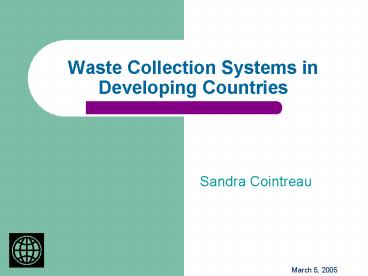Waste Collection Systems in Developing Countries PowerPoint PPT Presentation
1 / 26
Title: Waste Collection Systems in Developing Countries
1
Waste Collection Systems in Developing Countries
- Sandra Cointreau
2
Collection Costs are High and Service Levels are
Low
- Total Collection Costs Require 0.5 to 2.5 of
per capita income (as Gross National Product) - Service Typically Covers only 30-70 of the
Urban Population - Service is Infrequent (often less than once a
every two weeks for the urban poor)
3
INEFFICIENCIES IN SOLID WASTE COLLECTION ARE
CAUSED BY
- Poor Labor Management and Supervision,
- More Workers on the Roles Than Needed
- Inadequate Cooperation from the Citizenry with
Collection Schedules and Methods - Inappropriate Type and Size of Collection Vehicles
4
INEFFICIENCIES IN SOLID WASTE COLLECTION ARE
CAUSED BY
- Non-Rational Routes for Collection Service
- Failure to Optimize Vehicle Productivity by
Selecting the Appropriate Crew Size and Shift
Duration - Inadequate Communal Container Capacity at the
Communal Collection Points
5
INEFFICIENCIES IN SOLID WASTE COLLECTION ARE
CAUSED BY
- Long Vehicle Down Times from Poor Equipment
Maintenance and Repair - Long Haulage Times to Disposal Sites Coupled with
Lack of Transfer Stations - Harsh Driving Conditions at Disposal Sites Cause
Vehicle and Tire Damage
6
Collection Options to Consider for Optimizing
Costs and Productivity
- Route Type
- Vehicle Type
- Vehicle Size
- Crew Size
- Length of Shift
- Number of Shifts
- Public Operator
- Private Operator
Private Contractor, Quito, Ecuador, 1998
7
Route Types
- Piles along street
- Door to door
- Communal container stops with liftable bins
- Larger communal container stops with roll-on
containers
Liftable Container, Izmir, Turkey, 1994
Arm-Roll Container, Sekondi, Ghana, 1997
8
Route Type
Bell/Schedule System, Riga, Latvia, 1995
Collection Point for Carts, Enugu, Nigeria, 1992
9
Vehicle Types
- Small power tiller, hand cart, mini-truck
- Slow moving tractor and trailer, animal cart
- Fast moving open tipper truck, rear loader
truck - Container lifting roll on, skip, mechanical arm
for carts
Accra, Ghana, 1997
Kukkattpally, India, 2001
10
Vehicle Types
Arm Roll Container, Ahmedabad, India, 2001
Market Skip Lift Containers, Tema, Ghana, 1994
11
Vehicle Types
Open Tipper Lifts Hand Carts, Hue, Vietnam, 1996
Mini Private Truck, Bangalore, India, 2001
12
Vehicle Types
Private Open Tipper, Quito, Ecuador, 1998
Rear Loading Compactor, Shanghai, China, 1998
13
Crew Size and System of Loading
- Vehicle productivity more important in LDCs than
worker productivity - Arrange crew size to optimize vehicle
productivity - Facilitate method of loading
Bombay, India, 1995
Ica, Peru, 1984
14
Crew Size
Bangalore, India, 2001
Izmir, Turkey, 1994
15
Length of Shift
- Arrange shift length to get full loads in
collection vehicle - Private sector may be more flexible to have
extended shift lengths
Private Contractor, Jakarta, Indonesia, 1992
16
Number of Shifts
- Two shifts may have lower costs than one shift by
getting more productivity per vehicle (and
transfer facility) - Issue of change in drivers and time for
maintenance/repair - Private sector more flexible to work different
hours and night shifts
17
Public versus Private Operator
- Different financing costs
- Different overhead costs
- Different salaries and benefit costs
- Different insurance, tax, registration, and
marketing costs (also corruption costs) - Different length of hours of work and
productivity per worker - Different vehicle availability
- Different accountability per contractual
specifications
18
Private Sector Service
Woman-Owned Micro-Enterprise, Quito, Ecuador, 1998
Women-Owned Cooperative, Kukkattpally India, 2001
19
Private Sector Service
Private Contractor, Tema, Ghana, 1996
NGO-Managed Waste Recyclers with New Collection
Routes, Bangalore, India, 2001
20
Vehicle Type
21
Crew Size Comparison
- 5-person crew had lower cost/tonne than 4-person
crew - Larger crew could load vehicle faster and
optimize vehicle productivity
22
Public versus Private Worker Productivity
23
Public versus Private Vehicle Productivity
24
Public versus Private Costs
- Total costs for private versus public were so
close in Quito, it was decided to maintain a
balance of each, and gradually decrease
government to about 30 through natural attrition.
25
Transfer Economics
- Assess the breakpoint for each type of truck
- 6 cm. tipper was at 25 km, compared to 10 cm rear
loader at 40 km
26
COSTS CAN BE REDUCED SIGNIFICANTLY
- Appropriate Collection Technologies for Route
Conditions - Demand-Driven Approach to Involving People in
their Service Choices - Social Surveys - Rationalize Operations Crew Size, Vehicle Size,
Route Design, and Transfer Stations - Monitor Performance with Weighbridges
- Accountable Financing - Leak Proof Segregated
Accounts - Transparent Competitive Private Sector
Procurements

